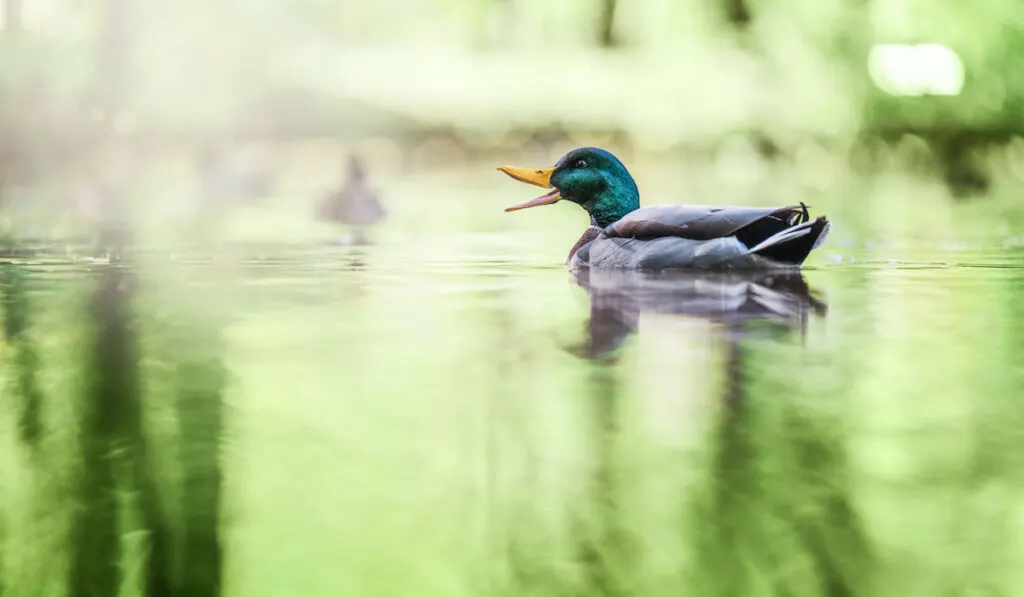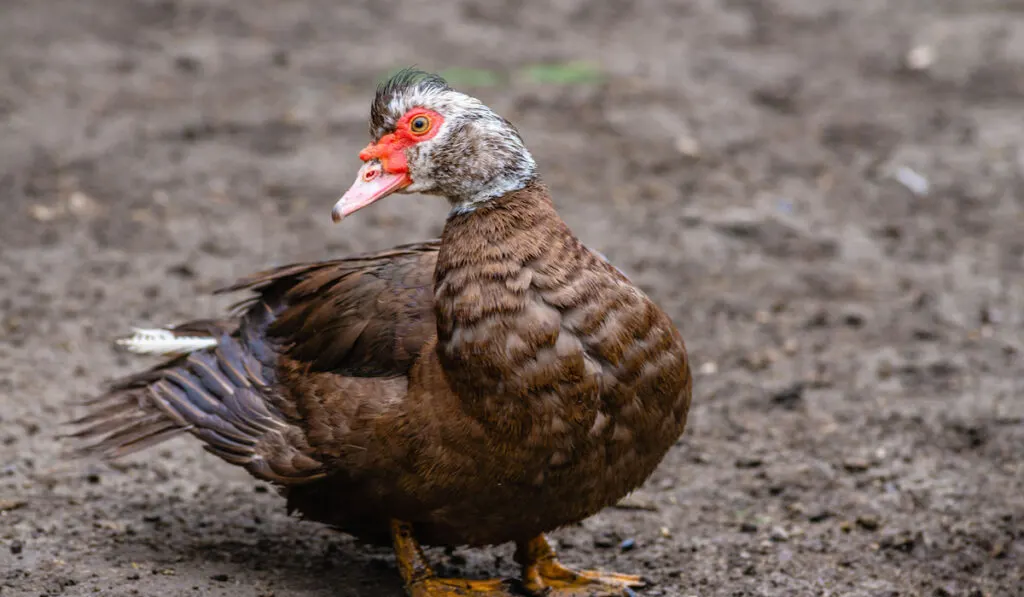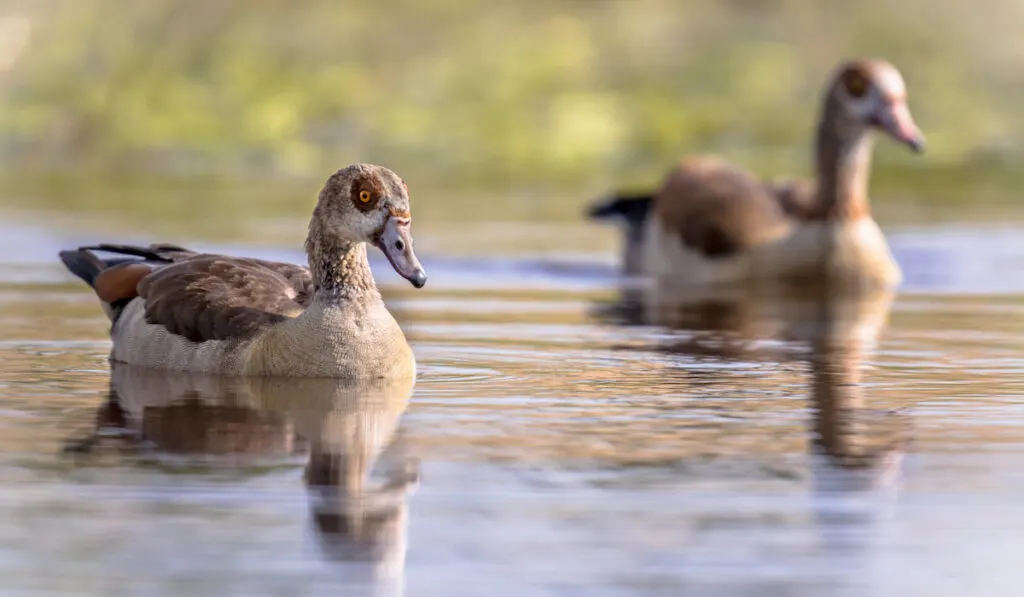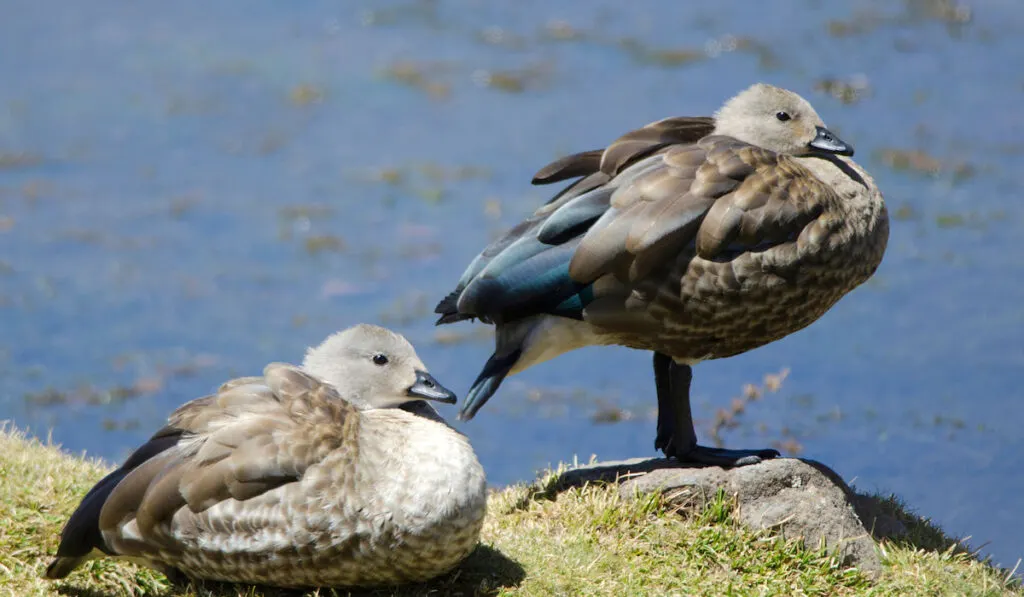Globally, there are around 167 species of waterfowl that include ducks, geese, and swans. More than 60 species exist in North America, which include domestic species and types we have rarely heard of.
Recent data has shown that the total population of ducks in the United States is around 34.2 million out of 7.2 billion North American birds in total.
Some of these wild and rare species are related to common breeds, while others fall under their own class and don’t interbreed with one another. That being said, let’s take a look at each type and discover what makes them unique and different.
Table of Contents
Anserinae – Swans and Geese

There are only two types of waterfowl that belong to the subfamily Anserinae, which are swans and geese. Although they belong to the same family of Anatidae, these two birds are categorized under two different genera, which are the genus Cygnus for swans and the genera Anser and Branta for geese.
From a physical standpoint, swans are much larger than geese. Some of the largest swan species that still exist today are the trumpeter swan, mute swan, and whooper swan. They live freely in wild habitats, usually in temperate regions with access to water bodies.
As for geese, they can be found both in the wild and domestic environments.
Geese comprise two categories: grey geese and white geese.
Although most geese migrate frequently to many different continents, there is one species that migrates only within North America, which is the Canada goose. They fly only to Canada, Alaska, Mexico, and the United States.
Anatinae

Similar to the Anserinae, the Anatinae are classified as the subfamily of the family Anatidae. Most waterfowl in this subfamily are dabbling ducks that fly and migrate frequently from one region to another.
Some of the duck species that belong in this subfamily are the African Black duck, blue-winged teal, silver teal, shoveler, true teal, falcated duck, wigeon, gadwall, Baikal teal, garganey, Mallard, knob-billed ducks, spot-billed duck, Indian spot-billed duck, and pintail ducks.
Waterfowl Species
Horned Screamer

Horned screamers are scientifically known as Anhima cornutas. They live in many parts of South America such as Colombia, Bolivia, Peru, Venezuela, Peru, Brazil, and Ecuador. These birds inhabit rivers, estuaries, lakes, ponds, and tropical lowlands.
Horned screamers are large waterfowl that measure around 28 to 36 inches and weigh around 7 pounds. Their wings can spread up to 6 feet wide. These birds have striking black and white bodies, yellow eyes, dark gray downward-curved bills, long grayish legs, and horn-like spines protruding on the top of their skulls.
Horned screamers thrive on an herbivorous diet that consists of grains, seeds, grasses, flowers, and other plant materials. Female birds can lay around 2 to 8 olive-brown eggs that take around 40 to 47 days to be incubated. They will nest close to water, usually on top of floating vegetation.
Bufflehead

Being one of the native waterfowl species in North America, these birds can be found in various parts of Canada, Alaska, as well as the United States. Their habitats vary from ponds to lakes, to open wetlands and estuaries.
Buffleheads have striking black-and-white bodies and iridescent dark green and purple faces. But what separates male birds from females is the shape of their heads. Male birds have globe-shaped, large heads while the females have round and smaller heads.
Furthermore, female birds have distinct mottled-brown plumage and white patches under their eyes. You won’t find these two colors on any male birds.
These small diving ducks primarily feed on aquatic insects, larvae, seeds, and mollusks. Female buffleheads typically lay 6 to 11 eggs per clutch that take 28 to 33 days to be incubated. They also nest in hollow cavities or tree holes.
Common Merganser

Common mergansers exist in numerous parts of the world such as Europe, Asia, and North America.
They usually inhabit diverse types of environments such as coastal bays, rivers, lakes, ponds, and freshwater areas. However, unlike some waterfowl, they don’t prefer to settle or spend their time in saltwater regions.
Common mergansers are also known as goosanders. Male mergansers can be recognized by their iridescent, dark green head and back, and white bodies. Meanwhile, female birds are slightly different with crested brown heads and grayish-white bodies.
On average, these waterfowl measure 23 to 28 inches long and weigh 2.2 to 4.4 pounds.
Being diving ducks, these birds feed underwater on various things such as fish, shrimps, mussels, aquatic insects, and occasionally, some plant materials. Common mergansers usually nest in tree cavities and close to water. Female birds can lay 8 to 11 pale buff eggs before incubating them for 30 to 35 days.
Mallard

Mallard ducks are one of the most common duck species that live in Europe, Asia, and North America. In fact, they are one of the oldest species that give birth to many domestic ducks today.
These birds usually inhabit several types of water bodies including lakes, ponds, wetlands, marshes, estuaries, saltwater regions, swamps, and even brackish water.
You can spot mallard ducks by their brown bodies, dark green head, yellow bills, and orange feet. Meanwhile, female mallards are much duller with mottled brown plumage and smaller bodies.
On average, adult mallards measure around 20 to 26 inches long with a weight of around 2 to 3 pounds.
These dabbling ducks thrive on an omnivorous diet. Their main diet includes aquatic insects, mollusks, crustaceans, small fish, amphibians, seeds, and other plant materials.
Unlike many wild ducks, these birds usually nest far away from the water, in holes in the ground, or in tree cavities. Female ducks can lay 7 to 10 olive-white eggs per clutch before incubating them for up to 30 days tops.
Swan

Being one of the unique large waterfowl types that ever existed, swans inhabit diverse types of water bodies, regardless of their native habitats.
These birds can grow up to 5 feet long and weigh as heavy as 5 pounds. They are also frequent flyers, especially during their migration seasons.
It is estimated that there are about 7 swan species that exist in the world. These include the mute swan, black swan, tundra swan, black-necked swan, trumpeter swan, whistling swan, Bewick’s swan, and whooper swan.
Another interesting fact about swans is that these birds are monogamous creatures.
Both male and female swans will mate, feed, and spend most of their time together throughout their entire lives. Their diet consists of various things such as aquatic insects, amphibians, fish, seeds, tubers, leaves, and other plant materials.
On average, swans can live up to 12 years. But some species can even live to be 20 years old!
Wood Duck

These vibrant and colorful ducks live in Canada, Europe, as well as the United States. They spend most of their time on the water, usually near wooded lakes and swamps, ponds, riverbanks, marshes, and shallow waters. You will also see them gathering in flocks and rarely alone.
Wood ducks possess colorful bodies with a mix of green, chestnut, brown, white, and black colors.
They also have red eyes with whitish-yellow or orange bills. Female ducks can be distinguished by their light, mottled-brown bodies, and white rings around their eyes.
These dabbling ducks measure 19 to 21 inches long and weigh around 1.5 pounds. Their wings can also extend up to 29 inches wide. Wood ducks mainly thrive on an herbivorous diet. But occasionally, they will eat crustaceans and aquatic insects.
Eurasian Teal

Like their name, Eurasian teals exist in many parts of Eurasia. They are closely related to the North American green-winged teals.
These birds are also known as the common teals or Eurasian green-winged teals.
Their habitats vary from lakes to ponds, to bogs and sheltered water bodies. Eurasian teals have gray bodies, dark chestnut heads, and iridescent, dark green patches that run from both their eyes to the back of their head.
Meanwhile, female teals possess mottled, yellowish-brown plumage with darker backs and heads. These small waterfowl only measure 13 to 17 inches long with a weight of around 12 ounces.
Being monogamous birds, drakes will only breed with one female bird in a single breeding season. The female will then lay 5 to 16 white eggs before incubating them for 25 to 30 days. These birds build their nests in hidden spots, on the ground, and close to water.
Canada Goose

Also known as the Canadian geese, these birds are indigenous to North America. But they also live in New Zealand, Argentina, Japan, and other European countries.
These birds will spend most of their time socializing or nesting in many habitats such as swamps, wooded lakes, tundra, lakes, ponds, salt marshes, and freshwater regions.
Canada geese are large-sized birds that measure 30 to 43 inches long. They weigh 6 to 14 pounds with a wingspan of 50 to 73 inches. Female geese are much smaller and lighter than males. These birds possess black heads and necks, grayish-brown bodies, white chests, and white patches under their eyes.
Unlike most waterfowl, females from this species are identical to the males, except for their size.
These birds are migratory geese and usually move in large flocks. Female geese can lay 4 to 7 white eggs before incubating them for 25 to 28 days.
Canada geese are herbivores that primarily feed on seeds, berries, and other plants. However, they occasionally eat certain species of mollusks, insects, small fish, and crustaceans.
Greater Scaup

Greater scaups live in North America, Europe, and Asia. These waterfowl prefer to spend most of their time near saltwater regions, lakes ponds, tundras, as well as freshwater areas. It is in these areas that they also breed. They usually migrate in large flocks during the winter and prefer to settle near coastal water.
These birds possess iridescent greenish-black heads, black tails, white chests and wings, and grayish-white backs. They also have dull gray bills and yellow eyes. Meanwhile, female scaups have brown bodies with dark brown heads and white patches around their bills.
Adult scaups measure 17 to 19 inches long and weigh around 2 pounds.
Greater scaups are diving ducks that feed on aquatic plants and creatures. You can also find other scaup species, the lesser scaups flocking together with the greater scaups. The difference in their size is obvious and you can easily differentiate one species from another.
Tufted Duck

These black-and-white waterfowl inhabit slow-moving rivers, wetlands, lakes, and coastal waters in Europe, North America, Asia, and Africa. Both male and female ducks possess black bodies, except for the white flanks that can only be found in males and brown flanks that are found in females.
Tufted duck can grow up to 19 inches long and weigh 1 to 2 pounds. Their wings can extend up to 28 inches wide. These medium-sized birds can also be recognized by their long, backward-curved crest on the top of their skulls.
Like other omnivorous ducks, these birds survive by eating diverse types of food including mollusks, crustaceans, aquatic insects, snails, and other plant materials. They rarely fly alone and will usually spend most of their time in large flocks.
Generally, these birds live from 4 to 20 years, which is far longer than most waterfowl species.
Muscovy Duck

Muscovy ducks were first developed in Brazil. Since then, they have spread to other South and Central American countries.
They are also called forest ducks or greater wood ducks. These ducks are one of the many domestic species that are raised both for their meat and eggs.
One of the key characteristics of Muscovy ducks is the presence of red caruncles on their faces. Although they are usually found with black and white plumage, other varieties may also bear different plumage colors such as green, blue, brown, white, lavender, and pied.
Muscovy ducks typically lay between 8 to 21 cream-colored eggs per clutch and up to 200 eggs per year. Female ducks will incubate their eggs for 35 days while the drakes will guard and defend their nests.
Raising Muscovy ducks is fairly easy because they are friendly and resistant to many avian diseases.
Grey Geese

There are seven species of geese that belong in this same group or genus Anser, which are Greylag geese, bean geese, swan geese, bar-headed geese, greater white-fronted geese, lesser white-fronted geese, and pink-footed geese.
Out of all these species, Greylag geese are considered the largest. Almost all the geese in this group possess the same characteristics. For instance, they have grayish-white bodies, dark-colored primary feathers, orange-black bills, and pink or orange legs.
Mandarin Duck

These vibrant and colorful ducks are native to Asia, particularly in China, Japan, and Korea.
But they have also been introduced to many European countries including the United Kingdom, France, Denmark, Belgium, Germany, Russia, and the Netherlands. However, in the winter, these birds will prefer to spend their time in Asia.
Mandarin ducks have brownish-orange plumage mixed with dark blue, black, white, and purple stripes and patches.
They also have white breasts and bellies, red bills, and white patches that run from their eyes down to the back of their heads. Female ducks appear less vibrant with light brown plumage, dark brown heads, dark bills, and white stripes across their eyes.
These ducks measure 16 to 19 inches with a weight of around 1.5 pounds. Mandarin ducks are monogamous birds that usually nest in tree cavities or holes. On average, female ducks lay up to 12 white eggs per clutch. The eggs will be incubated for 28 to 30 days.
Common Eider

Being one of the common species of sea ducks that you can find on coastal waters, common eiders are large-sized waterfowl that can grow up to 28 inches long and weigh as heavy as 6 pounds.
This is why they are considered to be the largest sea ducks in the Northern hemisphere, especially in Europe. They also go by their other names such as Cuddy’s ducks and St. Cuthbert’s ducks.
Common eiders have striking black and white bodies, black caps, dull green coloration on the back of their heads, and dull brown bills.
Female eiders are completely different with brown plumage and dull gray bills. These birds mainly feed on marine creatures such as mollusks, crustaceans, crabs, and even starfish.
Screamer

Screamers are one of the few waterfowl species that are native to South America.
They are mostly distributed in Brazil, Colombia, Brazil, and Argentina. There are three types of screamers that you can find which are northern screamers, southern screamers, and horned screamers.
Screamers are large-sized birds that feed on different types of water bodies. You can find them in open wetlands, marshes, swamps, or any regions that are close to the water source. These birds are territorial by nature and usually perch on trees in their large flocks. They produce high-pitched noise that can be heard from miles away.
This call is usually used to alert other birds of incoming dangers or predator attacks. Female screamers can lay 2 to 7 white-spotted eggs per clutch. Both parents are responsible for incubating the eggs until they’re hatched.
Egyptian Goose

Egyptian geese are indigenous to Africa. But they also live in the United States, particularly in California, Texas, and Florida. In their native habitats, these birds are prey to many carnivorous animals such as lions, cheetahs, leopards, vultures, and even crocodiles.
These birds are also related to the large birds that belong to the genus Tadorna, shelducks. Egyptian geese possess gray bodies with dark brown backs and patches around their eyes.
Female birds are physically similar to males, except for their smaller bodies. But the easiest way to differentiate between male and female birds is by the sound they produce.
Male birds usually make a loud, hissing sound while females can produce quacks that resemble trumpet sounds.
On average, Egyptian geese measure 25 to 29 inches long with a weight of 2 to 9 pounds. These herbivorous birds mainly feed on seeds, grasses, leaves, and other plant materials.
Cygnini

Cygnini or tribe Cygnini is a classification given to a group of swans that belong to the same subfamily Anserinae and genus Cygnus. In this genus, seven species are classified as members of the tribe Cygnini.
These include the mute swan, black swan, whooper swan, tundra swan, Bewick swan, trumpeter swan, and black-necked swan. Another swan species was a member of the tribe Cygnini. Today however, they are categorized into their own group, which are Coscoroba swans.
Each species live in their own native habitats in different regions such as Europe, Asia, Iceland, and the United States.
Magpie Goose

Magpie geese possess distinct black and white bodies, long black necks, and yellowish-orange faces and legs. They live in northern and southern Australia, Tasmania, and New Guinea regions. Their habitats range from swamps to slow-moving rivers, freshwater lakes, and other open wetlands.
These large-sized birds can grow up to 36 inches long and weigh around 4.4 pounds. With their webbed feet, they are capable of feeding on both land and water, consuming aquatic plants, seeds, grasses, and other plant materials.
These herbivorous birds are often noisy and produce sounds that are similar to loud honks.
Female geese usually lay 3 to 8 eggs per clutch. The incubation period usually lasts for 24 to 35 days. Male geese are responsible for building their nests which are usually made on top of floating vegetation.
Nene

These cute and exotic birds are considered endangered species that can only be found in Hawaii. In fact, it is estimated their current population is just around 2,500 birds!
They are also known locally as the Hawaiian geese. These birds are closely related to the Canada geese. Hence, you will notice some resemblance in the color of their plumage.
Nene geese have black heads, buff-colored cheeks, and brown bodies with white stripes that start from their upper neck down until their tails. These medium-sized birds stand around 16 inches tall and weigh 3 to 7 pounds.
These birds only feed on plant materials, seeds, fruits, and flowers. On average, female nenes can lay 1 to 5 cream-colored eggs per clutch. They also build their nests on the ground.
These birds spend most of their time away from crowded areas. But if you ever visit Hawaii, you can find them near Hawaii Volcanoes National Park.
Southern Screamer

Southern screamers are widely spread in many parts of South America such as Argentina, Brazil, Peru, Bolivia, Uruguay, and Paraguay.
They are also called the crested screamers. These large birds can grow up to 35 inches long and weigh up to 10 pounds.
You would expect that with their large bodies, they would also have a large wingspan. But on average, their wings can only extend up to 22 inches. For this reason, they prefer to stay on the ground and do not migrate like other species.
Southern screamers possess dark gray plumage, pink faces and feet, and dark-colored short bills. They also have small and short crests projecting from the top of their skulls.
Southern screamers are monogamous birds that will mate with only one partner for life. Female birds lay 3 to 7 eggs per clutch inside their nests that are close to water. These birds thrive on an herbivorous diet but will also eat other small creatures from time to time.
Hooded Merganser

Hooded mergansers are the only species that belong to the genus Lophodytes. These waterfowl are native to North America. But a small population of these birds live in Canada and Europe. They are also categorized as the second smallest mergansers in the world.
Averaging 16 to 19 inches long, hooded mergansers can only reach a weight of 31 ounces tops. Contrary to their small bodies, they have quite a large wingspan that can extend up to 26 inches wide.
These birds can be characterized by their brownish-black bodies, crested-black heads with white coloration on each side of their crests, and yellow eyes. These crests are present in both sexes but are much smaller in females. Unlike the male, female bodies are covered with grayish-brown plumage.
Hooded mergansers are carnivorous birds that prey on fish, aquatic insects, and crustaceans. They usually nest on tree cavities and can lay 7 to 15 whitish-cream eggs per clutch.
Blue-winged geese

Blue-winged geese or Cyanochen cyanopteras only live and breed in their native place, Ethiopia. They are also known as the Abyssinian blue-winged geese. These birds are distributed in many types of habitats including lakes, marshes, rivers, bog pools, freshwater regions, and swamps.
Blue-winged geese possess grayish-brown bodies with dull-colored necks and heads, black bills, and dark-colored legs. They can grow up to 30 inches and weigh 3.3 pounds.
These birds thrive on an herbivorous diet. But they also eat mollusks, reptiles, and aquatic insects from time to time.
On average, female geese lay 4 to 7 eggs per clutch that take 30 to 35 days to be incubated.
These endemic birds are much quieter than other geese species.
However, they still can produce soft whistles, usually when courting with females.
Spur-winged geese

Spur-winged geese, or Plectopterus gambensis are large waterfowl that are native to Africa. With a body size of 30 to 45 inches and a weight of at least 12 pounds, they are considered the largest goose species in the world. These birds are also related to the shelducks.
Aside from their black and white bodies, spur-winged geese possess reddish-pink patches scattered all around their white faces, making them look like large chickens or turkeys.
But what makes these birds unique are spiny structures found on their wings that contain toxins derived from the blister beetle. However, these spines will only be used as their defense mechanism.
Spur-winged geese prefer to nest in hidden spots such as tree cavities, unoccupied old nests, and thick vegetation.
Final Thoughts
Some of these waterfowl live in their natural habitats while others will migrate from one region to another, especially during their breeding periods and seasonal changes. Depending on where you live, you might come across these birds from time to time.
Hopefully, with this information, you can quickly recognize and know how to differentiate each type from another.
Resources
- https://deltawaterfowl.org/2022-duck-survey-numbers-released/
- https://www.denverpost.com/2019/09/20/bird-population-decrease-third-fewer/
- https://www.birds-of-north-america.net/waterfowl.html
- https://birdfact.com/articles/canada-goose-migration
- https://www.ducks.org/hunting/waterfowl-hunting-tips/waterfowl-of-the-world
- https://en.wikipedia.org/wiki/Anserinae
- https://en.wikipedia.org/wiki/Swan
- https://en.wikipedia.org/wiki/Goose
- https://beautyofbirds.com/anatinae/
- https://kids.kiddle.co/Anatinae
- https://animaldiversity.org/accounts/Anhima_cornuta/
- https://en.wikipedia.org/wiki/Horned_screamer
- https://animaldiversity.org/accounts/Bucephala_albeola/
- https://www.ducks.org/hunting/waterfowl-id/bufflehead
- https://animalia.bio/common-merganser
- https://www.audubon.org/field-guide/bird/common-merganser
- https://www.nationalgeographic.com/animals/birds/facts/mallard
- https://www.audubon.org/field-guide/bird/mallard
- https://www.animalspot.net/swan
- https://pondinformer.com/swan-species-guide/
- https://www.audubon.org/field-guide/bird/wood-duck
- https://animalia.bio/wood-duck
- https://en.wikipedia.org/wiki/Eurasian_teal
- https://animalia.bio/eurasian-teal
- https://www.audubon.org/field-guide/bird/canada-goose
- https://en.wikipedia.org/wiki/Canada_goose
- https://www.ducks.org/hunting/waterfowl-id/greater-scaup
- https://www.allaboutbirds.org/guide/Greater_Scaup/overview
- https://animalia.bio/tufted-duck
- https://www.rspb.org.uk/birds-and-wildlife/wildlife-guides/bird-a-z/tufted-duck/
- https://www.hww.ca/en/wildlife/birds/common-eider.html#sid4
- https://en.wikipedia.org/wiki/Common_eider
- https://www.thehappychickencoop.com/muscovy-duck/
- http://afs.okstate.edu/breeds/poultry/ducks/muscovy/index.html/
- http://www.wildfowl-photography.co.uk/identification/identgeeseanser.htm
- https://animalia.bio/mandarin-duck
- https://www.wildlifetrusts.org/wildlife-explorer/birds/waterfowl/mandarin-duck
- http://what-when-how.com/birds/screamers-birds/
- https://beautyofbirds.com/screamers/
- https://en.wikipedia.org/wiki/Egyptian_goose
- https://animalia.bio/egyptian-goose
- https://en.wikipedia.org/wiki/Tadorna
- https://www.vulkaner.no/n/birds/swan/swans.html
- http://www.damisela.com/zoo/ave/otros/anser/anatidos/cisne/taxae.htm
- https://seaworld.org/animals/facts/birds/magpie-goose/
- https://en.wikipedia.org/wiki/Magpie_goose
- https://www.hawaiimagazine.com/7-fun-facts-about-the-nene-or-hawaiian-goose/
- https://en.wikipedia.org/wiki/Nene_(bird)
- https://abcbirds.org/bird/southern-screamer/
- https://en.wikipedia.org/wiki/Southern_screamer
- https://animaldiversity.org/accounts/Lophodytes_cucullatus/
- https://en.wikipedia.org/wiki/Hooded_merganser
- https://seaworld.org/animals/facts/birds/abyssinian-blue-winged-goose/
- https://en.wikipedia.org/wiki/Blue-winged_goose
- https://beautyofbirds.com/spurwingedgeese/
- https://onekindplanet.org/animal/spur-winged-goose/
